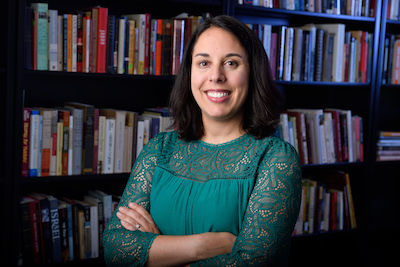New book delves into Holocaust victims’ emotions about perpetrators
August 28, 2023 - Beth Brauer
A new book written by Amy Simon, William and Audrey Farber Family Chair in Holocaust Studies and European Jewish History with joint appointments in James Madison College and the Department of History in the College of Social Science, explores the diaries of Holocaust victims as they catalogued their thoughts and feelings about their perpetrators. Published in June 2023 by Routledge, Simon’s first book “Emotions in Yiddish Ghetto Diaries: Encountering Persecutors and Questioning Humanity,” seeks to address what Holocaust and Jewish Studies literature hasn’t done in the past.

Simon, a core member of the Serling Institute for Jewish Studies and Modern Israel at Michigan State University, lived in Washington D.C. from 2008-2016 where she held the Leon Milman Memorial Fellowship at the U.S. Holocaust Memorial Museum and later worked on a digital history project there. Simon’s research examines questions of victim-perpetrator relationships during the Holocaust.
I examine the thoughts of people experiencing these different acts of perpetration, using their own words — what they saw and who they saw doing it.
Born from research Simon did for her doctoral dissertation that explored Holocaust victims’ perceptions of their perpetrators, “Emotions in Yiddish Ghetto Diaries,” further explores the range of emotions people experienced toward the different types of perpetrators.

“Instead of taking the approach of identifying the different types of perpetrators and examining their acts, which is what typically happens in Holocaust histories, I examine the thoughts of people experiencing these different acts of perpetration, using their own words — what they saw and who they saw doing it,” said Simon.
Simon includes excerpts from approximately 30 different diaries written entirely in Yiddish, the mother-tongue of many Jewish people in central and eastern Europe before the Holocaust. All of the diarists were men living in the three main ghettos: Warsaw, Vilna and Lodz. While many women kept diaries, those that survived were written in languages other than Yiddish.
In addition to utilizing the archives in the National Holocaust Museum in D.C., Simon accessed archives in New York and Jerusalem.
Simon is an advocate of using diaries as a method to collect and teach history. “Diaries are inherently interesting as they provide access to history in a personal way,” Simon said.
“Whether you study the Holocaust or have an interest in narratives, I think this is a book that many would appreciate. It is about people and their feelings, and it provides a different lens to understand what people were dealing with as it happened.”

